How To Use Google Analytics | Beginners Guide
How To Use Google Analytics | Beginners Guide
Have your ever listed to the word Analytics, what is the mean of Analytics it means inquiring about something. Google Analytics is the super free tool for the webmasters to inquire about their sites using a free features control panel. Webmaster have to signup for the Analytics Account and install the Analytics Code or ID to their sites that’s it now Google Analytics will start tracking your site and will display very useful information of your site, visitors, pages and anything you want to know. That’s why Analytics is highly recommended for every website. Below is the complete article about Analytics it includes following topics;
What is Google Analytics or Google Visitors Tracking Code?
- Benefits of Using Google Analytics
- How Google Analytics Works?
- Information About Google Analytics
How To Sign Up For Google Analytics and Install Analytics Code on Blogger, WordPress and Tumblr Blogs
- Installing Analytics To Blogger Blogs
- Installing Analytics To WordPress Blogs
- Installing Analytics on Tumblr Blogs
Setting the Site’s Search With Google Analytics
Setting Up Goals For Your Site
- What are Goals?
- Create Your First Goal In Analytics
Introduction To The Different Tools And Features Of Google Analytics
- Main Menu of Google Analytics
- Reports of Any Analytics Property
Viewing Data from Google Analytics
What is Google Analytics or Google Visitors Tracking Code?
Google Analytics or Google Visitors Tracking Code is a code which is added to web pages to track the visitors of any particle site or web page where that code is installed. The data is saved and is displayed on a Google Analytics account.
Benefits of Using Google Analytics
There are many benefits of using Google Analytics or Google visitors tracking code. Some of them are described below.
- It is very useful for those websites which use Google AdSense because they can target their Ads according to their audience or their interest so it boosts their income. AdSense has recently added the feature to link Analytics with AdSense.
- Tells the webmaster what their visitors like to read on their sites.
- Gives information about the visitors such as from which country they get most of the visitors the main source of their visitors, the browser of the visitors and the operating system of the visitors etc.
- The main interest of their visitors.
- Most popular and best pages of the site that visitors liked the most.
- There are many more benefits of using Google Analytics important are described above.
How Google Analytics Works?
When any user signup for Google Analytics, Google gives a code to the user to put that into his website when the code is installed on the website Google starts tracking the website using his specific algorithm.
Information About Google Analytics
- Google uses hierarchies to organize your Analytics Account.
- Under one Google Account (Gmail) you can create 100 (one hundred) Analytics Accounts.
- Under a single Analytics Account, you can add up to 50 (Fifty) properties.
- Under one website property, you have 25 views.
Tip For Beginners: If you are beginner in the field of Blogging or Analytics then never sign up for Analytics with other’s Google Account like your web designer, SEO Expert, Friends etc. because if you ever part ways then the person will take your Analytics and you have to start again from toe to read the head.
How To Sign Up For Google Analytics and Install Analytics Code on Blogger, WordPress and Tumblr Blogs
Google Analytics is a free service for tracking the websites. Signing up for Analytics and adding Analytics code to Blogger is very easily just follow the following quick steps.
Open Google Chrome (Any browser you have) and search for Google Analytics in the search bar. Open the first result i.e. official site of Google Analytics.
In the Homepage of Google Analytics you will see three steps i) Sign Up For Analytics ii) Add the tracking code iii) Learn about your audience. We will follow all of this option so just click on the Sign Up button there.
 |
| How To Sign Up For Google Analytics |
A new page will be loaded after clicking on the Sign UP button first you have to select what you want to track? Here we are going to track the audience of a site (Blog) so select website there.
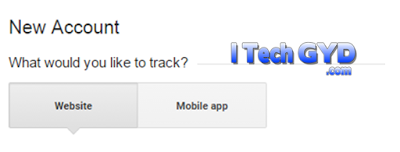 |
| How To Sign Up For Google Analytics |
Now you have to choose a name for your Account it may be your own name your site name or the name of the organization.
 |
| How To Sign Up For Google Analytics |
The next step is to describe your site it includes four fields;
- Website name: Enter the name or Title of your site (Blog) here.
- Website URL: Go to your website, copy the URL and paste here.
- Industry Category: What your website is about select one from the list by clicking on the down arrow sign. If you do not found any then click on OTHER.
- Reporting Time Zone: What is your time zone and which time zone you want to use for getting information about your site using Google Analytics. I am from Pakistan and my time zone is Karachi so I select it.
Data Sharing setting is the next step, Data Sharing means sharing your site data with Google Analytics and other services of Google. I and Google highly recommended you to check all the options for better results and improvement.
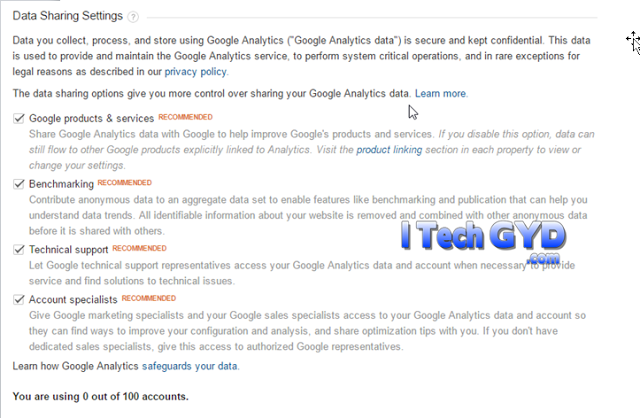 |
| How To Sign Up For Google Analytics |
At last, your Analytics account will be created in next two seconds of your accepting of Google Analytics Terms of Service Agreement now find the tracking ID and tracking code like below in there.
Installing Analytics To Blogger Blogs
Copy the Tracking ID there and go to Blogger.com select Other under the Setting options. Scroll down to the bottom of the page and find Google Analytics option there. Paste your Tracking ID in the Analytics field and click on the Save Setting button at the top right corner of the page.
 |
| Installing Analytics To Blogger Blogs |
Installing Analytics To WordPress Blogs
Installing Analytics on Tumblr Blogs
Setting the Site’s Search With Google Analytics
Setting the Site’s search mean tracking the searching data of your site. This is only applicable to those sites which have a search bar on it.
But there are two kinds of search boxes, if you want to use it for blogger blog then you have to add search widget manually otherwise most Blogger template have their own search widget which does not support Google Analytics search data. For example, if you go to itechgyd.com and search for “How To Create Blog” my search box will show the results without changing URL of the page. But if I had added search widget manually and you search for “How To Create Blog” on any page then the URL of my site would change to itechgyd.com/search_results?q=How To Create Blog. So open your blog and search any content of your site if the URL of your site is changed then you can follow the following steps otherwise first you have to add a custom search widget for your blog.
Login to your Gmail account and go to the Homepage of Google Analytics and click on the Admin tab there.
In right View column selects the View Settings option.
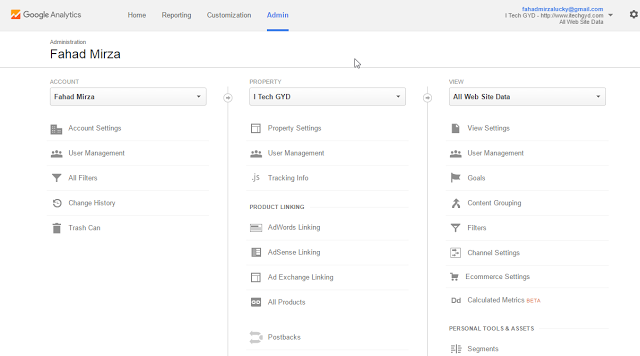 |
| Setting the Site’s Search With Google Analytics |
Setting Up Goals For Your Site
What are Goals?
In our normal life Goal mean the thing which we want to complete in the same way when you set a goal in the Analytics you set a task. Not understanding? I am explaining. If you have a marketing or lead generation site you would like to measure the signup of your visitors, A goal is used to represent a completed activity on a specified site.
Goals settings are not recommended for any site but these are very useful for any site as it can give a good impression to your Analytics Data. I think the first think that one should do after installing Analytics Code to blogger blog is to create goals.
Create Your First Goal In Analytics
Login to your Google Account and go to the homepage of Google Analytics.
In the homepage click on the Admin tab on the top menu. Click on the Goals option under the View Column at the right side.
 |
| Create Your First Goal In Analytics |
Goals option will be expanded like below picture just click on the red button + New Goal button.
 |
| Create Your First Goal In Analytics |
There are three steps to create a Goal in Google Analytics i)Goal Setup ii)Goad Description iii) Goal Details.
- Goal Setup: In this field select the Custom option and click on the Next Step button.

Create Your First Goal In Analytics - Goal Description: Here you have to choose a name for your Goal, select nay one which you can remember. Remain the Goal Slot ID untouched. In the Type field select Destination and finally click on the Next Step button.
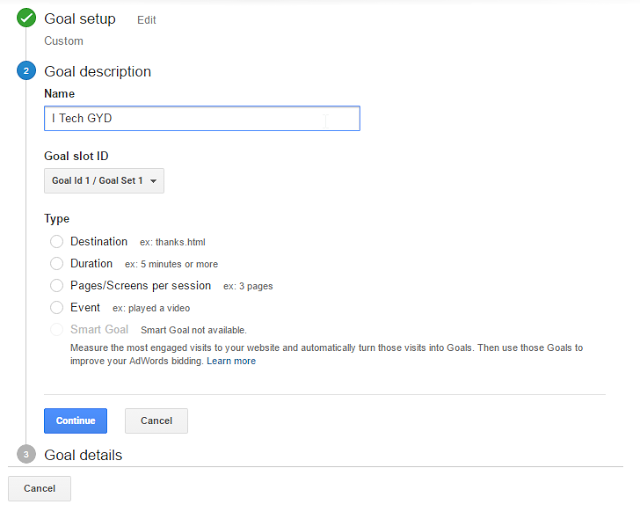
Create Your First Goal In Analytics - Goal Details: Here you have to select the Destination of your goal, click on the drop-down and select Begins With option. Enter the URL of your page after the Domain Name of your blog.
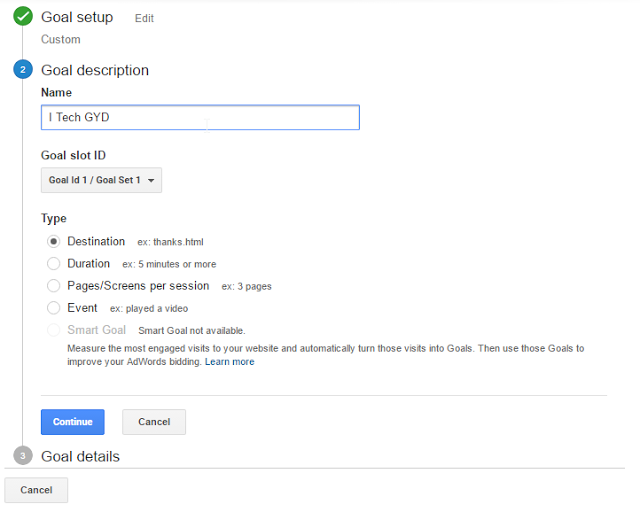
Create Your First Goal In Analytics
Remain the Value and Funnel option untouched.
Finally, click on the Save button below and that’s it you have successfully created your first Goal for your site now you will get started getting information about your goals in the Analytics.
 |
| Create Your First Goal In Analytics |
That’s it you have successfully enabled the site search for your site and also created first goal for your site.
Introduction To The Different Tools And Features Of Google Analytics
Knowing about the tools and different features of Google Analytics is very important, because once you get familiar with Analytics’s tools you can use it easily.
So, read the below post carefully.
Google Analytics has two types of menus one is the main menu while the second is on the left side of any property.
Main Menu of Google Analytics
 |
| Main Menu of Google Analytics |
Main Menu of Google Analytics has following options.
- Home
- Reporting
- Customization
- Admin
Home Page of Google Analytics
 |
| Home Page of Google Analytics |
On the Home page of Analytics, you see all the website properties which you have added. In front of the property, the number of Sessions, Average Sessions Duration, Bonus Rate and Goal Conversion Rate click on any website property to see all the data about the selected property.
Reporting Tab of Analytics
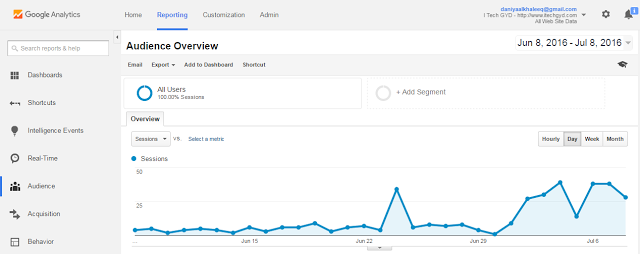 |
| Reporting Tab of Analytics |
Reporting Tab shows you an overview of your selected property. This overview includes a graph which shows the New Visitors and Returning Visitors, a table including Demographics, System, Mobile and Language etc.
Customization Tab of Google Analytics
Customization tab has information about the custom reports which you create. When you create a report the report is called custom report.
Click on the +New Custom Report button, enter a title for your report.
Select the type of report from Explorer, Flat Table, or Map Overlay.
On Metric group field click on +add metric button choose your metric type here I choose the Goal which I had created for my site.
 |
| Report Name, Metric Group in Google Analytics |
In the same way, select the Dimension Drilldowns
If you want to limit the report of your custom report then you can add the filters.
Select All views associated with this account under the view option.
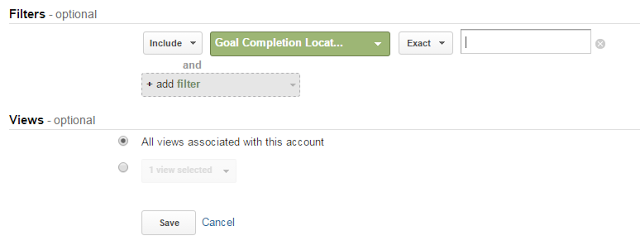 |
| Filters and Views in Google Analytics Customization Tab |
Admin Tab of Google Analytics
 |
| Admin Tab of Google Analytics |
Click on the Admin tab to get access to administrative features. You can use these tools to create new tools, change user permission and much more etc.
This page has three columns one is ACCOUNT second is PROPERTY and third is VIEW.
This was a little about the top menu of Google Analytics.
Reports of Any Analytics Property
Now come back to the Home page of your Analytics. Click on any property and you will see a new menu at the left side of your selected Analytics property. These options are as follow.
- Dashboards
- Shortcuts
- Intelligence Events
- Real Time
- Audience
- Acquisition
- Behavior
- Conversions
Dashboard
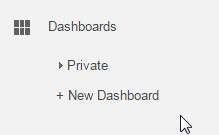 |
| Dashboard |
Here you can create small scale reports using Analytics apps. Users can also save cards on the dashboard. You can create as many reports as you want but these reports cannot be shared and are only visible on the mobile app.
Shortcuts
 |
| Shortcuts |
Using this option you can create shortcuts to different parts of your Analytics account. For example, you often see some reports you can set the shortcuts of these reports here so that you can easily access them. It is same as we create different shortcuts on Windows to access them easily.
Intelligence Events
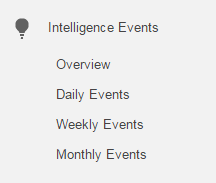 |
| Intelligence Events |
This option is further divided into four sub options which are Overview, Daily Events, Weekly Events, and Monthly Events.
- Overview: It shows the summary of different alerts triggered for active date ranges.
- Daily Events: Data changes day to day due to automatic and custom alerts triggered
- Weekly Events: Data changes week to week due to automatic and custom alerts triggered
- Daily Events: Data changes week to week due to automatic and custom alerts triggered
Real Time
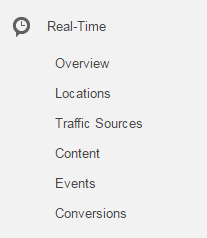 |
| Real Time |
In my view the real time is the best option in the Analytics there are many but the real time is the best one as it allows us to monitor the activities as they happen on our site or blogs. It also tells which posts or pages users are interacting with. It also allows us to monitor the goal conversion in real time.
Audience
Audience report provides us about 50% information about our audience in whole Analytics. It provides reports insight it the characteristics of our audience. It has also many sub options like to follow;
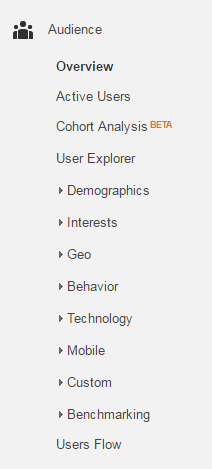 |
| Audience |
- Active Users: Lets you track the active users of your site for 1, 7, 14 or 30 days.
- Lifetime Value: You can understand how different users are valuable for your site based on the lifetime performance.
- Cohort Analysis: Cohort is a group of users that share identical characteristics and this information is identified in this section.
- Demographics: Using this option you can understand about your visitors or users various information such as Operating System they are using, Age, Gender, Language, and country etc. this information is very useful for increasing the revenue of the sites using AdSense by targeting the ads according to this data.
- Interests: Makes it easy to understand the interests of the visitors. So that you can write contents according to the interests and also useful for targeting the Google Ads based on visitors interests.
- Geo: Geo tells the Language and location of your visitors. When you understand the language of visitors then you can target your ads more effectively, for example, your ads are in English but most users of your site use Italian you can use this option to improve the language of your site while the location describes from where you get most of the visitors.
- Behavior: Behavior means the how you impact on your visitors so that they come again to your site. For example, I visit on your blog what will you do on your site which makes me go again and again on your site.
- Technology: Tells you what your users uses to read to your sites I mean are they using computer or mobile? What is the browser your visitors uses? Etc. This will make you ready to change your site according to your visitors. As now people are moving from computers to mobiles so that you can design your website according to the mobile browsers and apps.
- Mobile (Devices): You will be aware that users are migrating from computers to mobile devices. This option tells you what device they are using what is the resolution of the screen of their devices etc.
- Custom: If you want to extend the scope of your different segments then you can use the Custom variable for this purpose.
- Benchmarking: This option lets you compare your Analytics data with other site or companies who share their data, by doing this you can get many benefits and knew something which you should do to improve your site.
- Users Flow: User flow mean the movement of users on your site. For example, if you want to know what visitors or users do on your site then you can use this tool.
Acquisition
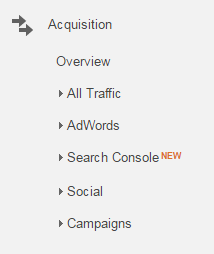 |
| Acquisition |
The acquisition is just available for the website properties it cannot be used for apps. It can be used to find the sources of traffic on your site, for example, you can find either visitors have used a search engine to reach your site or they are directly reached at your site. How your campaigns are successful in attracting the visitors.
- Behavior: This report tells you how users use your site, how they interact with your site etc.
Conversions
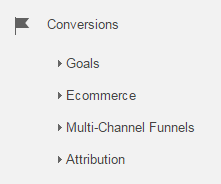 |
| Conversions |
If you have created Goals on your Analytics account then you can find how many conversions your website has received. The path that was used to complete the goal. You can also see the number of conversions made from a specific country.
Viewing Data from Google Analytics
Once you have signed up for Analytics you will get started getting data from your Analytics account in next 24 hours. To see the data of your site login to your Google Account and go to the Google Analytics you will the Audience overview report. This report will be shown every time you log in to your analytics account but if you have many websites under one account all of them will be listed there from there you have to choose one.
Switch between different websites in Analytics
To switch between sites click on the arrow sign at the right top corner and select the site whose Audience overview report you want to see or click on the Home tab at the top and select the website whose audience overview you want to see.
Comparing Data of different days, week and months
If you want to compare data from different dates, weeks or months then you can do so easily. Click on the drop-down sign beside the dates. Tick the “Compare to” button and select dates to compare the data you are viewing.
Changing the Overview Duration
If you want to change the duration of the Overview you can change it to Hourly, Week, Month or Year. Hourly will show you the hourly reports in the same way Week will show the weekly reports, the month will show the monthly reports and year will show the yearly reports.
Getting Data from Graph and Metrics
You can also view data from the Graph and metrics by just hovering the mouse pointer over the graph and matrices. Hover the pointer over the Graph line will show you some details like a number of session on a specific date and day while hovering the pointer over the metrics will describe the simple definition of that metric.
New & Returning Visitors
On the right side of matrices, there is a round graph which will tell you the number of visitors which are new on your blog and the number of visitors which are returning to your blog. This can be helpful for finding the value of your site.
Demographics, System, Mobile
- Demographics describe the Language, Country and the City of the visitors.
- The system describes Browser, Operating System and Service Provider of the visitors.
- Mobile describes the Operating System, Service Provide and Screen Resolution of the visitors.
Select anyone from the above and click on the view Full Report link to view full report of the select item. In the full reports, you can get too much information such as the city from where you get the maximum number of visits the country from you get the maximum number of visitors in the same way the Operating system of PC and Mobile devices which your visitors uses.
Select the Screen Resolution under the Mobile option and click on the view full report link there you can see the most used resolution of the screen for the mobile device. You can edit your template or theme in the way.
Language
Final Words
Google Analytics is must for every site. Especially for new sites because Google understands that this site is real and providing value to users. It also helps Google to understand better about the site stats. Keep in mind whenever you published your 1st post on your site, you’ll connect your site to analytics. It also helps you to check out your site progress. You check each and everything about your site progress. Its so easy to use for everyone just you have to understand all the above options and your job is done. Google analytics checks your site 24 hours and tells you real time stats.
There is no any best alternative then this one. It is Google’s property so we can say that it is safe and secure to use. No matter what is your site topic, it can analyse all the topics or niches. We almost mentioned all the features of this tool above. You can check them all carefully and can better understand your site. It tells you what user is experiencing on your site and how user behaving with your site. If you see any negativity of users, you can correct it and provide more value to users.
The main options are visitors and bounce rate. Basically these two features are enough to understand your site. But you’ll must check other options as well. Because sometimes, other options can also help you to boost your site in search engine. So, this was our guide about what is Google analytics and how to use it. We hope you definitely like it and appreciate our efforts. You can share this post with your friends and co-workers and help them to understand it. If you have any question left in your mind, you can ask from us in the comment section.
More from my site
Hi. This is Faizan Gul. I am an Engineering Student and tech enthusiast. I love to practice new things and then write about them. In this blog, i would be writing about how to tech guides, tricks and tips and Tech Gadgets Reviews.

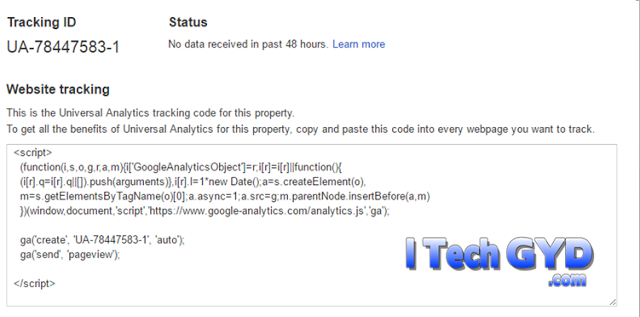







Leave a Reply
Want to join the discussion?Feel free to contribute!